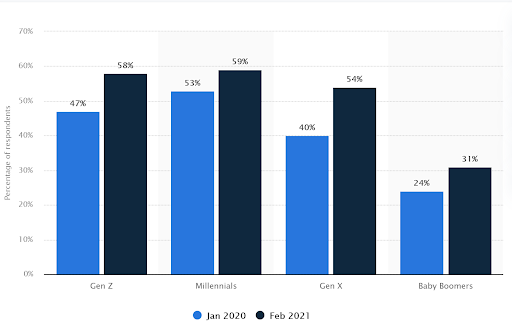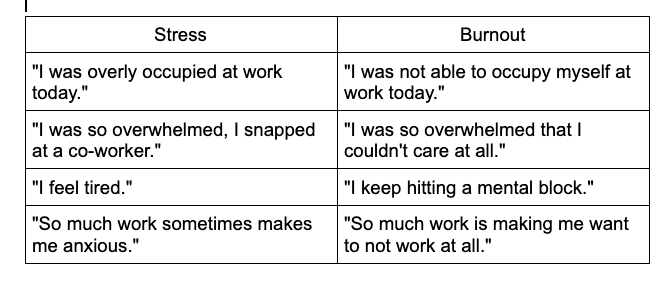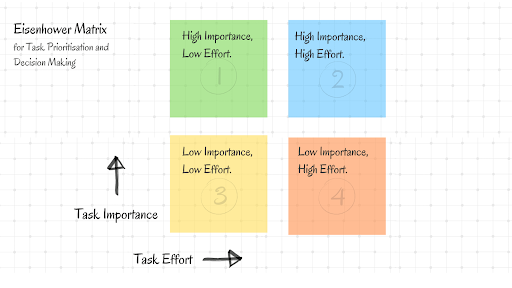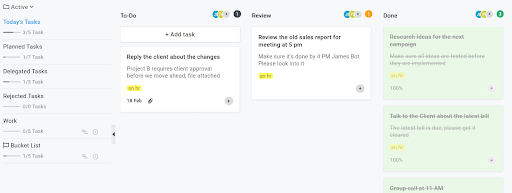

Feeling as if work stress has become an indispensable part of your routine? Well, you might say, “Since when was it not?” but if stress is depriving you of your mental peace, upending your sleep cycle, and leaving you exhausted even on weekends — it’s a significant clue telling you your stress is turning into burnout.
There is statistical evidence of the Covid-19 pandemic making the burnout situation even worse. In addition, the stay-at-home lifestyle is a major disruption affecting both the physical and mental health of employees.


Percentage of U.S. employees who had feelings of burnout pre-COVID Jan. 2020 vs. Feb. 2021, by generation – Source
The above data shows that professionals across generations have reported comparatively higher burnout in February of 2021.
Millennials and Gen Z, which were already topping the charts, saw a similar incline, with burnout cases rising to 59%. That’s more than half of the most significant generations making up the modern workforce today. A sharp rise can also be seen for Gen X.
Working from home, professionals are reportedly putting in 15 extra hours at work every week. The extra hours logged for work result from overstretched work hours and the inability to disconnect from work past the log-out time. Not to forget the social isolation and emotional distress that tags along when you don’t meet your co-workers that often.
Burnout has its roots deep into jam-packed routines and an inherent workaholic culture, which is bursting at the seams for many.
While we can’t ask employees to forego the hard work, we can make strategic amends in work planning for remote teams and in-office employees. Laborious, inefficient work ultimately creates more work to handle in a day, which will tip you to burnout more often than not.
This article looks closely into what burnout is and how intelligent work planning can lift you out of burnout — alongside strategies to deal with burnout-causing emotions.
So, what does burnout feel like?
Work stress and burnout at work aren’t the same thing. Stress is part and parcel of being a professional but burnout is characterized by feelings you sure would want to avoid.
In the Leading Through Burnout study, which interviewed 35 Chief Medical Officers, striking dissimilarities were found. For example, about 69% of CMOs reported alarmingly high degrees of daily work stress, but only a very few reported burnouts. This is because most of these officers were emotionally equipped to handle their burnout-causing stress.
Let’s look at some commonly experienced feelings of stress and how they differ from burnout.


It’s also important to note that burnout changes how you think and act. Apparently, when you face consistent burnout, your brain naturally switches its behavior to an essentials-only mode. As a result, your creative side begins to diminish, and you don’t feel like investing in work anymore.
How does Inefficient Work Management Result in Burnout?
Handling workload efficiently and distributing work tasks wisely are two traits that every manager must possess. Disorderly management often contributes to increased process errors which eat away at employee productivity and morale. Lower productivity doesn’t take long before it creeps into the feeling of burnout.
Following are a few signs of burnout-causing management inefficiencies.
Unplanned work is more work.
Unplanned work is similar to packing your travel suitcase without conscience. You’ll never be able to fit your items properly if you randomly throw in stuff. You’d need to layout everything carefully so that every nook and cranny is utilized to the last inch.
Managers need to be especially aware of not stressing employees with the burden of unplanned work. Those last-minute tasks and shifting priority items can overwhelm employees with too much to deal with.
Other factors such as long feedback loops, not distributing work evenly throughout the week, and impromptu changes in work schedules only make the employees work for longer hours.
In the USA, employees work for 41.5 hours in a typical workweek on average. However, about 11% of employees reported working for more than 40 hours also. In Columbia, it can even stretch to alarmingly high 49.8 hours in a week.
Not setting clear work expectations.
Have you ever chased a single task for the entire week because the client wasn’t happy with your work? Post-delivery revisions are all right, but when you keep running in circles for the same task, it can feel extremely annoying.
Imagine working in an organization where this is the norm. Employees keep struggling with task revisions, simply because they’re not clear as to how to go about the task in the first attempt. Apparently, 46% of work stress is reportedly experienced due to overwhelming workload.
An overwhelming workload highlights a hidden anomaly in team communication. If managers are unable to assign work with crystal clear expectations, somewhere, the flow of communication is not appropriate. In addition, employees can feel a decline in their mental health in case they find their manager to not be a good communicator.
Repetitively working on tasks can cause frustration, exhaustion, and above all – loss of direction, which emotionally sabotages employee engagement.
Workplace chaos is contagious.
Mismanagement gives rise to the most significant productivity deterrent — chaos.
If the employees feel that they’re not being cared for at the workplace or the company’s management is bad at relaying information, it can lead to poor job satisfaction.
53% of Americans feel unhappy at work, and about 80% feel stressed in case the company communication isn’t effective. Being in an organization that feels chaotic can become a burnout furnace in no time.
Therefore, managing communication and professional relationships at work is extremely important in preventing burnout.
Smart scheduling for curbing burnout at work
Now that we have comprehended a few reasons why burnout occurs and the role of management in the same, let’s see how we can use smart scheduling to reduce burnout levels in employees.
Work-from-home isn’t work-forever.
As more teams work from home, managers need to be wary of the fact that employees find it hard to unplug from work and usually find their own rhythm. In addition, if task assignments are not moderated to last a workday, it can further intensify the problem of overworking.
Hence managers need to cut out work so that employees don’t have to extend their work-from-home hours beyond a certain point. An odd working Saturday shouldn’t hurt anyone, but every day shouldn’t feel like a stretch.
The best way to understand if employees are able to accommodate assigned workload healthily is by tracking logged-in hours and holding daily debriefs.
A project management tool that helps you communicate and get detailed employee activity insights. ProofHub, Workday, and TimeDoctor are some software products that help managers get meaningful insights into employee productivity patterns.
The bottom line is to maintain the same 8-hour workday at home as is expected in the office.
Take burnout breaks.
One of the leading causes of burnout is long hours of work without a refresher in between. For this, Tony Schwartz, founder of the Energy Project – an organization dedicated to enabling companies to perform better, suggests “intermittent renewal.”
It’s essentially a technique of taking a break after every 90 minutes to cool down from burnout-causing work stress. Schwartz also suggests taking breaks to tune out of work monotony that might push you towards demotivation and detachment.
Now, alongside employees, managers must understand when to bake in these non-productive hours. It’s also understandable that not every employee would want to take a burnout break at the same time, due to which, managers must be ready to offer flexible work routines.
Flexible scheduling makes it easy for everyone in the team to manage their own burnout relief period. It’s a growing norm among remote teams to schedule work with flexible calendars, wherein employees self-assign tasks and meet deadlines without having to follow a hard-coded work routine.
Working with priority lists
If your manager ever tells you that “everything is urgent” on your to-do list, you’re most definitely preparing for burnout.
Task priorities are extremely important for building feasibility in your workweek. However, it’s more than obvious that not all tasks carry the same level of urgency and priority. Some tasks should purposefully wait in case you’re already facing a time crunch. Trying to do it all at once will ensure that nothing gets done.
Prioritizing also frees you enough time to take breaks. One of the finest methods of work prioritization can be learned from Eisenhower Matrix, which lays down a quick framework for scheduling tasks using definite priorities. It basically tells you to classify tasks as per their effort and importance.


EISENHOWER MATRIX
Everything that can be done right away usually appears on the top of your to-do list. High-effort tasks are planned out in eventual steps. Low effort and low importance tasks are either delegated or deleted completely.
Using this technique ensures that you’re not overstuffing your calendar. You can also exercise the freedom to pass on lower-priority tasks to someone in a better position to execute them.
We’ve recreated the Eisenhower Priority Matrix using a project management tool to elucidate this concept better.
As shown, you can create four lists containing, Today’s Tasks, Planned Tasks, Delegated Tasks, and Rejected Tasks.
You can quickly shuffle tasks into these four lists as per their priority to bring sanity to your work calendar. It’s good for your manager as well, as they’ll stay informed on how to orchestrate with other team members.


TODAY’S TASKS
Streamline Your Workflow
Do you work in a collaborative environment where multiple stakeholders work on the same task? Chances are that although your workplace demands team members to actively collaborate, an efficient workflow to enable the same is missing.
Most tasks follow an assembly-line pattern. Each stakeholder contributes to the task and passes it on to the next link in the chain. If this assembly line isn’t proficiently synchronized, each member would have to put in extra effort to make it work.
This extra struggle can easily pile up on individual employees, leading to increased stress and eventual burnout.
Binding a definite workflow around your work tasks and scheduling each stage of the workflow smartly, will help you smoothen out the task completion process.
Agile workflow employed by software development teams is one of the best inspirations for building a continuous workflow. This is because it tries to define each stage in the workflow with defined responsibilities without being too restrictive.
Agile workflows for non-technical teams are gaining popularity as they can help all kinds of collaborative organizations reduce process conflicts.
In 2018, the government workers at the City of San Jose adopted Agile workflow to manage their daily duties. It helped them streamline their activities and boost productivity across the board.
Grouping similar tasks together
In a research paper enlisted in the Journal of Experimental Psychology, it was found that carrying out similar tasks in succession produces better focus and productivity, in contrast to dissimilar tasks.
The research highlights the fact that when you’re switching between intrinsically different tasks such as updating a spreadsheet and listening to audio recordings – you’ll often find it hard to develop that prime focus.
Therefore, it’s advisable to batch similar activities together to stay productive and finish off tasks without hurting your cognition. For example, if you’ve some number crunching scheduled for 12:00 AM and 4:00 PM, try clubbing the tasks together and paddle through them in one continuous session.
The continuous sessions of work will reduce the mental flex that often goes into handling dissimilar tasks – enabling you to keep work stress under control.
Conclusion
Burnout may seem inevitable, but it’s avoidable. Overworking and under-prioritizing significantly contribute to burnout. With the right kind of work scheduling and enough cool-down period, you’d be able to prevent yourself from slipping into burnout every other day.
As they say, occasional stress is normal; chronic stress is not. If you face burnout too often, talk to your manager to figure out how your work routine can be altered to accommodate your mental health.
Although coming out of the natural tendency to burn yourself out is difficult, be patient and kind as you slowly proceed to let go of “all work and no rest.”











John Hall
John Hall is the co-founder of Calendar a scheduling and time management app. He’s also a keynote speaker that you can book at http://www.johnhallspeaking.com.